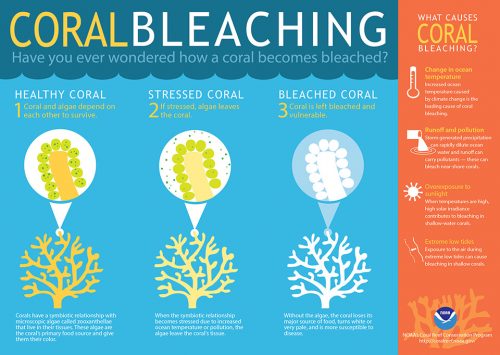Florida is home to the only barrier reef in the continental U.S. and the third largest coral reef in the world, next to the Belize and Great Barrier reefs. In just 40 years, corals have declined in some areas by more than 90%.
Dalton Hesley, a senior research associate at the University of Miami Rosenstiel School of Marine and Atmospheric Science, said the Florida reef has seen a dramatic decline in coral cover. Coral cover is an indicator of general reef health that describes the proportion of reef surface covered by live stony coral instead of sponges, algae or other organisms. Historically, coral cover on Florida’s reefs was between 30 and 40%. Today, coral cover in Florida is only between 2 and 5%.
“That just goes to show how close we are to zero percent. This might not be a 100-year problem. This could be a 10 –years–from–now problem, if not sooner,” Hesley said.

Florida and Caribbean reefs were subjected to bleaching and disease events years before mass bleaching events killed a third of the corals on the Great Barrier Reef in Australia. For this reason, Florida scientists have had a head start in the ongoing race to save corals from extinction.
Now scientists from Florida and Australia are teaming up and sharing data to help speed up the healing process. To do so, they are testing restoration methods using corals that appear to be more resistant to common threats like warming ocean temperatures and ocean acidification through a process called assisted evolution.
“Assisted evolution is simply trying to better understand how these coral species and these ecosystems would be reshaped over time considering the different changes we’re seeing,” Hesley said. “For example, if corals are likely to develop a resilience or resistance to increased ocean temperatures or certain coral diseases, is there a way to guide them down that road?”
Although the restoration techniques in Florida may not directly transfer to the Great Barrier reef due to its sheer size, scientists are able to learn from the methods and adjust accordingly. One of the biggest takeaways from this work is that reefs in the future will look much different than they do today.
Hesley explained future reefs will need to be able to adapt to warmer waters, a more acidic ocean chemistry and higher levels of nutrients. We can also expect increased stress on corals thanks to a growing human population.
“When we restore coral populations, we’re trying to best design them with these things in mind,” Hesley said. “So if we expect ocean temperatures to be higher in the future, then we can deliberately outplant or restore corals that are better resistant to increased ocean temperatures.”
Although the situation is dire, Hesley said there is hope on the horizon.
“Between active coral reef restoration, ongoing coral reef research and increased public involvement, we really can recover these ecosystems and create a sustainable future,” Hesley said.
Taking steps to lower your carbon footprint, getting involved by participating in citizen science programs or donating to coral restoration are just a few ways to restore and preserve Florida’s reefs for the next generation.
“It really will take transformative social change to build the future that we really want to see,” Hesley said.
Learn more about how you can help coral reefs by visiting our post: Coral Reefs Are in Trouble: Here’s How You Can Help
Watch the video below to learn more about Hesley’s work with coral restoration.